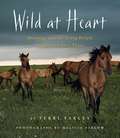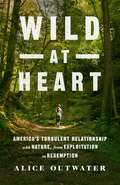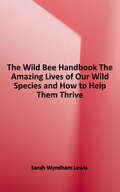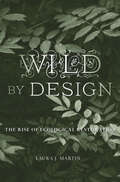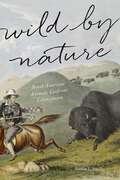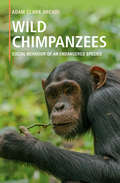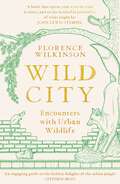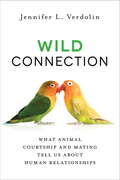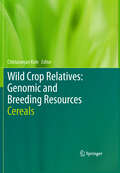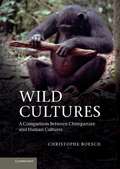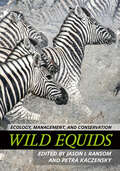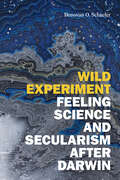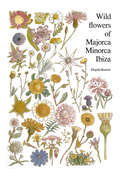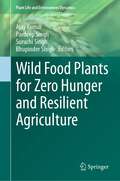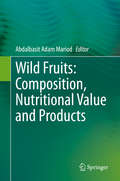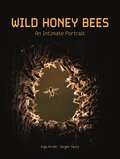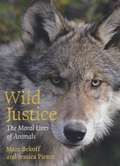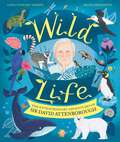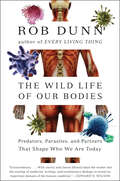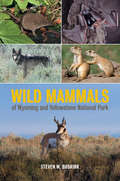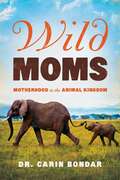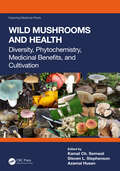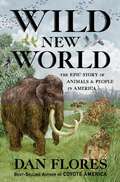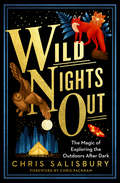- Table View
- List View
Wild at Heart: Mustangs and the Young People Fighting to Save Them
by Terri Farley Melissa FarlowMustangs have thrived for thousands of generations. But now they are under attack from people who see them as pests. The lucky ones are adopted. Some are sent to long-term holding pens; more and more are sold for slaughter. But courageous young people are trying to stop the round-ups and the senseless killings. They are standing up to the government and big business to save these American icons. With eye witness accounts, cutting-edge science, and full-color photographs, Terri Farley and Melissa Farlow invite readers into the world of mustangs in all its beauty, and profile the young people leading the charge to keep horses wild and free. Includes notes and sources, index, and glossary.
Wild at Heart: America's Turbulent Relationship with Nature, from Exploitation to Redemption
by Alice Outwater"Alice Outwater’s infectiously readable Wild at Heart captures the essence of ecology: Everything is connected, and every connection leads to ourselves." —Alan Weisman, author, The World Without Us and Countdown "A wonderful book. Information rich to say the least, and the indigenous human connections and portrait of the deep connectivity of nature, are both strong elements." —Jim McClintock, author of A Naturalist Goes Fishing Nature on the brink? Maybe not. With so much bad news in the world, we forget how much environmental progress has been made. In a narrative that reaches from Native American tribal practices to public health and commercial hunting, Wild at Heart shows how western attitudes towards nature have changed dramatically in the last five hundred years.The Chinook gave thanks for King Salmon's gifts. The Puritans saw Nature as a frightening wilderness, full of "uncooked meat." With the industrial revolution, nature was despoiled and simultaneously celebrated as a source of the sublime. With little forethought and great greed, Americans killed the last passenger pigeon, wiped out the old growth forests, and dumped so much oil in the rivers that they burst into flame. But in the span of a few decades, our relationship with nature has evolved to a more sophisticated sense of interdependence that brings us full circle. Across the US, people are taking individual action, planting native species and fighting for projects like dam removal and wolf restoration. Cities are embracing nature, too.Humans can learn from the past, and our choices today will determine whether nature survives. Like the First Nations, all nations must come to deep agreement that nature needs protection. This compelling book reveals both how we got here and our own and nature's astonishing ability to mutually regenerate.
The Wild Bee Handbook: The Amazing Lives of Our Wild Species and How to Help Them Thrive
by Sarah Wyndham-LewisThere are over 20,000 species of bees worldwide, of which just seven species are honeybees. In the US alone, there are over 4,000 species of bee, whereas Europe only have nearly 2,000 bee species and the UK has 275.The Wild Bee Handbook is a practical, illustrated guide that will introduce you to the common wild bees you might find in your garden. Through a handy directory, learn how vital wild bees are to the ecosystem and discover how we can garden to offer them the food and habitat they need. This book is an essential resource for anyone interested in biodiversity and sustainable gardening, featuring sections on container gardening, the no-dig method, how to maintain soil health, the principles for rewilding and wildflower gardening for success - it doesn't matter how big or small your space, you can still garden to support wild bees. The Wild Bee Handbook is a celebration of the wild pollinators and a beautifully illustrated, informative guide that will equip you to create a green space to help them thrive. Join the wave of change and learn how to grow sustainability.
Wild by Design: The Rise of Ecological Restoration
by Laura J. MartinAn environmental historian delves into the history, science, and philosophy of a paradoxical pursuit: the century-old quest to design natural places and create wild species. Environmental restoration is a global pursuit and a major political concern. Governments, nonprofits, private corporations, and other institutions spend billions of dollars each year to remove invasive species, build wetlands, and reintroduce species driven from their habitats. But restoration has not always been so intensively practiced. It began as the pastime of a few wildflower enthusiasts and the first practitioners of the new scientific discipline of ecology. Restoration has been a touchstone of US environmentalism since the beginning of the twentieth century. Diverging from popular ideas about preservation, which romanticized nature as an Eden to be left untouched by human hands, and conservation, the managed use of natural resources, restoration emerged as a “third way.” Restorationists grappled with the deepest puzzles of human care for life on earth: How to intervene in nature for nature’s own sake? What are the natural baselines that humans should aim to restore? Is it possible to design nature without destroying wildness? Laura J. Martin shows how, over time, amateur and professional ecologists, interest groups, and government agencies coalesced around a mode of environmental management that sought to respect the world-making, and even the decision-making, of other species. At the same time, restoration science reshaped material environments in ways that powerfully influenced what we understand the wild to be. In Wild by Design, restoration’s past provides vital knowledge for climate change policy. But Martin also offers something more—a meditation on what it means to be wild and a call for ecological restoration that is socially just.
Wild by Nature: North American Animals Confront Colonization
by Andrea L. SmalleyHow did efforts to control wild animals affect colonization?Winner of the CHOICE Outstanding Academic Title of the Choice ACRLFrom the time Europeans first came to the New World until the closing of the frontier, the benefits of abundant wild animals—from beavers and wolves to fish, deer, and bison—appeared as a recurring theme in colonizing discourses. Explorers, travelers, surveyors, naturalists, and other promoters routinely advertised the richness of the American faunal environment and speculated about the ways in which animals could be made to serve their colonial projects. In practice, however, American animals proved far less malleable to colonizers’ designs. Their behaviors constrained an English colonial vision of a reinvented and rationalized American landscape. In Wild by Nature, Andrea L. Smalley argues that Anglo-American authorities’ unceasing efforts to convert indigenous beasts into colonized creatures frequently produced unsettling results that threatened colonizers’ control over the land and the people. Not simply acted upon by being commodified, harvested, and exterminated, wild animals were active subjects in the colonial story, altering its outcome in unanticipated ways. These creatures became legal actors—subjects of statutes, issues in court cases, and parties to treaties—in a centuries-long colonizing process that was reenacted on successive wild animal frontiers. Following a trail of human–animal encounters from the seventeenth-century Chesapeake to the Civil War–era southern plains, Smalley shows how wild beasts and their human pursuers repeatedly transgressed the lines lawmakers drew to demarcate colonial sovereignty and control, confounding attempts to enclose both people and animals inside a legal frame. She also explores how, to possess the land, colonizers had to find new ways to contain animals without destroying the wildness that made those creatures valuable to English settler societies in the first place. Offering fresh perspectives on colonial, legal, environmental, and Native American history, Wild by Nature reenvisions the familiar stories of early America as animal tales.
Wild Chimpanzees: Social Behavior of an Endangered Species
by Adam Clark ArcadiAs our closest primate relatives, chimpanzees offer tantalizing clues about the behavior of early human ancestors. This book provides a rich and detailed portrait of chimpanzee social life in the wild, synthesizing hundreds of thousands of hours of research at seven long-term field sites. Why are the social lives of males and females so different? Why do groups of males sometimes seek out and kill neighboring individuals? Do chimpanzees cooperate when they hunt monkeys? Is their vocal behaviour like human speech? Are there different chimpanzee 'cultures'? Addressing these questions and more, Adam Arcadi presents a fascinating introduction to the chimpanzee social universe and the challenges we face in trying to save this species from extinction. With extensive notes organized by field site and an appendix describing field methods, this book is indispensable for students, researchers, and anyone else interested in the remarkable and complex world of these intelligent apes.
Wild City: Encounters With Urban Wildlife
by Florence Wilkinson'The mark of a good nature book is that it opens your eyes to what is there, but you missed, and then to the beautiful possibility of what might be. This is a very good book.' John Lewis-Stempel'An enjoyable and timely reminder that we are never alone' Tristan GooleyThe badgers of Brighton's most exclusive postcode. The water voles of Glasgow. The Black Country bats who have found a haven in old industrial tunnels. The peregrine falcons nesting on the ledges of tower blocks. The mosquitoes found on the London Underground and nowhere else on earth.In Wild City Florence Wilkinson takes us on a fascinating journey into why we should engage with our fellow urban species. What we might see - if we only take the time to look - and how nature is adapting to human-engineered environments in unexpected and ingenious ways.As more and more of our planet is urbanised, we humans still feel that primal pull to connect with our wilder roots. This gorgeously lyrical book invites us to celebrate the natural world, while also offering a clear-eyed glimpse into the challenges faced by urban plants and animals as cities grow and sprawl.Wild City proposes a compelling manifesto for city wildlife, suggesting how we might take action to protect the often-overlooked residents who live alongside us.City-dwellers, it's time to meet your neighbours.
Wild Connection
by Jennifer L. VerdolinWild Kingdom meets Sex and the City in this scientific perspective on dating and relationships.A specialist in animal behavior compares the courtship rituals and mating behaviors of animals to their human equivalents, revealing the many and often surprising ways we are both similar to and different from other species.What makes an individual attractive to the opposite sex? Does size matter? Why do we tend to "keep score" in our relationships? From perfume and cosmetics to online dating and therapy, our ultimate goal is to successfully connect with someone. So why is romance such an effort for humans, while animals have little trouble getting it right? Wild Connection is full of fascinating and suggestive observations about animal behavior. For example, in most species smell is an important component of determining compatibility. So are we humans doing the right thing by masking our natural scents with soaps and colognes? Royal albatrosses have a lengthy courtship period lasting several years. These birds instinctively know that casual hook-ups are not the way to find a reliable mate. And older female chimpanzees often mate with younger males. Is this the evolutionary basis of the human "cougar" phenomenon?Fun to read as well as educational, this unique take on the perennial human quest to find the ideal mate shows that we have much to learn from our cousins in the wild.
Wild Crop Relatives: Genomic and Breeding Resources
by Chittaranjan KoleWild crop relatives are now playing a significant part in the elucidation and improvement of the genomes of their cultivated counterparts. This work includes comprehensive examinations of the status, origin, distribution, morphology, cytology, genetic diversity and available genetic and genomic resources of numerous wild crop relatives, as well as of their evolution and phylogenetic relationship. Further topics include their role as model plants, genetic erosion and conservation efforts, and their domestication for the purposes of bioenergy, phytomedicines, nutraceuticals and phytoremediation. Wild Crop Relatives: Genomic and Breeding Resources comprises 10 volumes on Cereals, Millets and Grasses, Oilseeds, Legume Crops and Forages, Vegetables, Temperate Fruits, Tropical and Subtropical Fruits, Industrial Crops, Plantation and Ornamental Crops, and Forest Trees. It contains 125 chapters written by nearly 400 well-known authors from about 40 countries.
Wild Cultures
by Christophe BoeschHow do chimpanzees say, 'I want to have sex with you?' By clipping a leaf or knocking on a tree trunk? How do they eat live aggressive ants? By using a short stick with one hand or long stick with both? Ivorian and Tanzanian chimpanzees answer these questions differently, as would humans from France and China if asked how they eat rice. Christophe Boesch takes readers into the lives of chimpanzees from different African regions, highlighting the debate about culture. His ethnography reveals how simple techniques have evolved into complex ones, how teaching styles differ, how material culture widens access to new food sources and how youngsters learn culture. This journey reveals many parallels between humans and chimpanzees and points to striking differences. Written in a vivid and accessible style, Wild Cultures places the reader in social and ecological contexts that shed light on our twin cultures.
Wild Ecosystems, Unit 6: Nature's Neighborhoods
by Wright Group/McGraw-HillThis is a textbook about the connection of living things in the wild ecosystem.
Wild Equids: Ecology, Management, and Conservation
by Jason I. Ransom Petra KaczenskyThe first expert synthesis of the diverse studies conducted on wild equids worldwide.Wild horses, zebras, asses, and feral equines exhibit intriguing and complex social structures that captivate the human imagination and elicit a wide range of emotions that influence conservation and management efforts. This book, spearheaded by Jason I. Ransom and Petra Kaczensky, brings together the world's leading experts on equid ecology, management, and conservation to provide a synthesis of what is known about these iconic species and what needs to be done to prevent losing some of them altogether. The most comprehensive conservation book on wild equids in decades, this title will enlighten not only equid researchers, but also mammalogists, conservationists, and equine professionals. Readers will find new insight into the lives of the world's horses, zebras, and asses, understand the basis of our relationships with these animals, and develop a greater understanding of where equids come from and why they are worth conserving.Included in this book are detailed, state-of-the-science syntheses on Social structure, behavior, and cognition Habitat and diet Ecological niches Population dynamics Roles of humans in horse distribution through time Human dimensions and the meaning of wild Management of free-roaming horses Captive breeding of wild equids Conservation of wild equids Conservation of migrations Reintroductions Genetics and paleogenetics
Wild Experiment: Feeling Science and Secularism after Darwin
by Donovan O. SchaeferIn Wild Experiment, Donovan O. Schaefer challenges the conventional wisdom that feeling and thinking are separate. Drawing on science studies, philosophy, affect theory, secularism studies, psychology, and contemporary literary criticism, Schaefer reconceptualizes rationality as defined by affective processes at every level. He introduces the model of “cogency theory” to reconsider the relationship between evolutionary biology and secularism, examining mid-nineteenth-century Darwinian controversies, the 1925 Scopes Trial, and the New Atheist movement of the 2000s. Along the way, Schaefer reappraises a range of related issues, from secular architecture at Oxford to American eugenics to contemporary climate denialism. These case studies locate the intersection of thinking and feeling in the way scientific rationality balances excited discovery with anxious scrutiny, in the fascination of conspiracy theories, and in how racist feelings assume the mantle of rational objectivity. The fact that cognition is felt, Schaefer demonstrates, is both why science succeeds and why it fails. He concludes that science, secularism, atheism, and reason itself are not separate from feeling but comprehensively defined by it.
Wild flowers of Majorca Minorca and Ibiza
by Elspeth BeckettVisitors to these islands in search of sun and sea are often surprised by theglorious wild flowers, abundant particularly in the spring and late autumn.Many are curious to know more about them.This book offers a means of identification on three levels.For the complete beginner there are illustrations of most of the more strikingwild plants (and of a few cultivated ones).For those who wish to go further, there is help in the form of a botanical key (abasic skill for would-be botanists, and what better place, than a sunny holidayisland to learn it in).For those who already have this skill here is a key to all the wild floweringplants ( except those waiting to be discovered - what a challenge for aninteresting holiday!).
Wild Food Plants for Zero Hunger and Resilient Agriculture (Plant Life and Environment Dynamics)
by Ajay Kumar Pardeep Singh Suruchi Singh Bhupinder SinghThe edited volume brings out a comprehensive collection of information relevant to wild food plants, their importance for global sustainable food security, future-readiness, and resilient agriculture. The book's primary focus is to cover topics on the diversity of wild food plants across the globe, their nutraceutical importance, production-consumption trends, integration into the current food menu, and marketing and livelihood opportunities to the indigenous people. Sustainable development goals 1, 2, and 3 are significant for a poverty-free, hunger-free world and ensure good health and wellbeing of the people, respectively. The three goals are important and interlinked as achieving zero poverty will help reduce hunger among the people. Availability of nutritional and balanced food ensures good health. Wild food plants are an essential part of a nourishing and healthy diet for indigenous communities. They are globally collected from natural habitats or cultivated at more minor scales. Although consumed locally, they are an essential part of the diets of tribal and indigenous communities worldwide and hold immense potential to alleviate global hunger. Considering their importance for global sustainable food security, it is essential to clearly understand the future role of wild food plants for future readiness and resilient agriculture. Therefore, this book provides a piece of important information on these aspects. The book is a valuable resource for the audience ranging from undergraduate science students to the NGOs and institutions involved in poverty alleviation programs, policymakers, dieticians, horticulturists, plant breeders, farmers, health experts, and food enthusiasts.
Wild Fruits: Composition, Nutritional Value and Products
by Abdalbasit Adam MariodWild fruits play an important role in mitigating hunger in the developing world. As a sustainable and natural food source in rural areas, these fruits have a strong effect on regional food security and poverty alleviation. This makes the utilization of wild foods incredibly important for native populations both in terms of food security and economics. There are many traditional methods for wild fruit harvesting, indigenous tree and plant domestication and cultivation passed down through generations that are sustainable and economically viable, ultimately contributing to a better quality of life for large sections of the developing world. To date there has not been a reference work focusing on the full scope of wild fruits from their growth and chemical makeup to their harvest, distribution, health effects and beyond. Wild Fruits: Composition, Nutritional Value and Products adequately fills this gap, expansively covering the utilization of multi-purpose wild fruits in regions worldwide. Effects on quality of life, food security, economics and health are extensively covered. Over 31 wild fruit species are examined, with individual chapters focusing on each species' phytochemical constituents, bioactive compounds, traditional and medicinal uses and chemical composition. Harvest, post-harvest and consumption methods are covered for each, as are their overall effect on the food security and economics of their native regions. This book is essential for researchers in search of a comprehensive singular source for the chemical makeups and cultivation of indigenous wild fruits and their many benefits to their native regions.
Wild Honey Bees: An Intimate Portrait
by Ingo Arndt Jürgen TautzA lavishly illustrated exploration of the mysterious, hidden world of forest-dwelling wild honey bees—with new insights that promise to revolutionize conservation and beekeepingThe honey bee, a key pollinator, is now an endangered species, threatened by human activity and loss of biodiversity. Because of this, understanding forest-dwelling wild honey bees—which are more resistant to diseases and parasites than honey bees kept by beekeepers—is more important than ever before. In this lavishly illustrated book, Ingo Arndt, one of the world’s best wildlife photographers, and Jürgen Tautz, one of the world’s leading bee experts, set out on the trail of wild honey bees, bringing back sensational photographs, some of which document behaviors never captured before, and new scientific insights that promise to revolutionize conservation and beekeeping.A remarkable number of wild honey bee colonies still exist, living in hollow trees inside the forest, largely unnoticed by humans. This book explores the fascinating secret world of wild honey bees, including the adaptations and behaviors they have acquired to survive and the new challenges they face today. Featuring incredible macro and wide-angle photographs, some taken from inside hives, Wild Honey Bees is a unique collaboration that documents a major research project and offers critical new insights about these essential creatures.A stunning photographic record that documents for the first time the original way of life of the endangered, forest-dwelling honey beeA unique collaboration between one of the world’s best wildlife photographers and one of its leading bee expertsFeatures incredible macro and wide-angle photographs, some from inside the hive, depicting bees as never seen beforeOffers fascinating new insights into the mysterious, hidden world of the wild honey bee
Wild Justice: The Moral Lives of Animals
by Marc Bekoff Jessica PierceMarrying years of behavioral and cognitive research with compelling and moving anecdotes, Bekoff and Pierce reveal that animals exhibit a broad repertoire of moral behaviors, including fairness, empathy, trust, and reciprocity. Underlying these behaviors is a complex and nuanced range of emotions, backed by a high degree of intelligence and surprising behavioral flexibility. Animals, in short, are incredibly adept social beings, relying on rules of conduct to navigate intricate social networks that are essential to their survival. Ultimately, Bekoff and Pierce draw the astonishing conclusion that there is no moral gap between humans and other species: morality is an evolved trait that we unquestionably share with other social mammals.
Wild Life: The Extraordinary Adventures of Sir David Attenborough
by Leisa Stewart-SharpeJourney through the jungle and coral reefs, across the African plains and icy poles, and even to the Galapagos Islands, as you discover all there is to know about the world's best-known and best-loved naturalist, Sir David Attenborough, in this beautifully illustrated non-fiction picture book.From a childhood spent searching for fossils to his awe-inspiring work as a broadcaster and conservationist, learn about Sir David Attenborough's WILD life, as you experience iconic moments from his documentaries and are inspired by his untiring efforts to protect our planet.A perfect gift for budding naturalists and fans of David's wildlife documentaries.
The Wild Life of Our Bodies: Predators, Parasites, and Partners That Shape Who We Are Today
by Rob DunnA biologist shows the influence of wild species on our well-being and the world and how nature still clings to us—and always will.We evolved in a wilderness of parasites, mutualists, and pathogens, but we no longer see ourselves as being part of nature and the broader community of life. In the name of progress and clean living, we scrub much of nature off our bodies and try to remove whole kinds of life—parasites, bacteria, mutualists, and predators—to allow ourselves to live free of wild danger. Nature, in this new world, is the landscape outside, a kind of living painting that is pleasant to contemplate but nice to have escaped. The truth, though, according to biologist Rob Dunn, is that while "clean living" has benefited us in some ways, it has also made us sicker in others. We are trapped in bodies that evolved to deal with the dependable presence of hundreds of other species. As Dunn reveals, our modern disconnect from the web of life has resulted in unprecedented effects that immunologists, evolutionary biologists, psychologists, and other scientists are only beginning to understand. Diabetes, autism, allergies, many anxiety disorders, autoimmune diseases, and even tooth, jaw, and vision problems are increasingly plaguing bodies that have been removed from the ecological context in which they existed for millennia. In this eye-opening, thoroughly researched, and well-reasoned book, Dunn considers the crossroads at which we find ourselves. Through the stories of visionaries, Dunn argues that we can create a richer nature, one in which we choose to surround ourselves with species that benefit us, not just those that, despite us, survive.
Wild Mammals of Wyoming and Yellowstone National Park
by Steven W. BuskirkWild Mammals of Wyoming and Yellowstone National Park provides the scholar, conservationist, and interested lay reader with information on the state's 117 wild mammalian species from grizzly bears to pygmy shrews. It describes the history of mammalogy in Wyoming, the zoogeography of Wyoming mammals, and the prehistoric mammals of Wyoming. It also characterizes the habitats of Wyoming mammals and addresses the conservation and management of mammals in the region. Expanding beyond the traditional field guide, Steven W. Buskirk emphasizes taxonomic classification, geographic range, and conservation status for mammalian species. Introductory sections are provided for each order and family, and individual species accounts organize a wealth of data ranging from habitat associations to field measurements in an easy-to-use format. Featuring color species photos, continental and state-scale distribution maps, and a comprehensive bibliography with nearly 1,000 references, Wild Mammals of Wyoming and Yellowstone National Park is an indispensable resource for wildlife and conservation biologists and mammalogists working in this region.
Wild Moms: Motherhood In The Animal Kingdom
by Carin BondarA fascinating and entertaining tour of motherhood in the animal kingdom that reveals a new perspective on the mother/child relationship. Being a mom is a tough job—but imagine doing it in the jungle or out on the safari, faced by the ravages of the elements, a scarcity of resources and the threat of predators prowling at all times of the day and night. In Wild Moms, Dr. Carin Bondar takes readers on an enthralling tour of the animal kingdom as she explores the phenomenon of motherhood in the wild. A journey through motherhood for the animal kingdom—from the initial phases of gestation and pregnancy through breastfeeding and toddler-rearing and trying to parent a teenager through empty nest syndrome (which, in many of these cases, is quite literal!) to being a grandmother. In Wild Moms, Dr. Bondar answers a whole host of questions about the animal kingdom: How do moms in the animal kingdom cope with crying babies and potty training? How does breastfeeding work in the wild—particularly when a mother is nursing not one baby at a time, but a whole litter? If children with disabilities do not fit into Darwin’s theory of evolution (I.e. Survival of the fittest), then why do we see mothers from various mammalian groups providing ongoing care to disabled offspring? Accessible and entertaining, Wild Moms is a celebration of moms everywhere—and a book guaranteed to make readers think about motherhood in an entirely new way.
Wild Mushrooms and Health: Diversity, Phytochemistry, Medicinal Benefits, and Cultivation (Exploring Medicinal Plants)
by Kamal Ch. Semwal Steven L. Stephenson Azamal HusenMedicinal mushrooms have been used since ancient times. Certain mushrooms can be used to treat numerous conditions, including those related to cardiovascular health, obesity, cholesterol balance, bone health, diabetes, and cancer. Wild Mushrooms and Health: Diversity, Phytochemistry, Medicinal Benefits, and Cultivation presents reports on numerous species of wild medicinal mushrooms with discussion of drug-discovery implications, analysis of bioactive substances, and prospects for cultivation. FEATURES Comprehensive review of medicinal mushrooms as sources of promising bioactive molecules and prospective compounds for drug discovery Information on diversity, distribution, ethnomycology, ecology, cultivation, descriptions of specific species, and folk medicinal uses of mushrooms throughout the world Emphasis on identification, documentation, bioactive substances, and the nature of mushroom bioactivity Discussion of the nutraceutical properties of wild mushrooms, including high protein content comparable to that of meat, and low fat content, which make them a complete dietary food source Exploration of methods used in the collection, identification, documentation, cultivation, analysis, and conservation of mushrooms for drug discovery An installment in the Exploring Medicinal Plants series, this volume is a comprehensive resource for medical researchers, scientists, and pharmaceutical companies. In addition, this resource is appropriate for mycologists and botanists interested in pharmacognosy.
Wild New World: The Epic Story Of Animals And People In America
by Dan FloresA deep-time history of animals and humans in North America, by the best-selling and award-winning author of Coyote America. In 1908, near Folsom, New Mexico, a cowboy discovered the remains of a herd of extinct giant bison. By examining flint points embedded in the bones, archeologists later determined that a band of humans had killed and butchered the animals 12,450 years ago. This discovery vastly expanded America’s known human history but also revealed the long-standing danger Homo sapiens presented to the continent’s evolutionary richness. Distinguished author Dan Flores’s ambitious history chronicles the epoch in which humans and animals have coexisted in the “wild new world” of North America—a place shaped both by its own grand evolutionary forces and by momentous arrivals from Asia, Africa, and Europe. With portraits of iconic creatures such as mammoths, horses, wolves, and bison, Flores describes the evolution and historical ecology of North America like never before. The arrival of humans precipitated an extraordinary disruption of this teeming environment. Flores treats humans not as a species apart but as a new animal entering two continents that had never seen our likes before. He shows how our long past as carnivorous hunters helped us settle America, initially establishing a coast-to-coast culture that lasted longer than the present United States. But humanity’s success had devastating consequences for other creatures. In telling this epic story, Flores traces the origins of today’s “Sixth Extinction” to the spread of humans around the world; tracks the story of a hundred centuries of Native America; explains how Old World ideologies precipitated 400 years of market-driven slaughter that devastated so many ancient American species; and explores the decline and miraculous recovery of species in recent decades. In thrilling narrative style, informed by genomic science, evolutionary biology, and environmental history, Flores celebrates the astonishing bestiary that arose on our continent and introduces the complex human cultures and individuals who hastened its eradication, studied America’s animals, and moved heaven and earth to rescue them. Eons in scope and continental in scale, Wild New World is a sweeping yet intimate Big History of the animal-human story in America.
Wild Nights Out: The Magic of Exploring the Outdoors After Dark
by Chris Salisbury"A fun, inventive adventure guide about helping children explore nature after dark . . . Its activities are a great excuse to turn off the television, set down smartphones, and explore the rich, mysterious world just beyond the back door."—Foreword Reviews The go-to guide for exploring nature at night, whether on summer holidays, weekends away or even back garden adventures! Foreword by Chris Packham, author, naturalist, and BBC presenter Learn how to call for owls, walk like a fox and expand your sensory perceptions. Wild Nights Out is a wonderful new hands-on guide for those who wish to take kids (of all ages) outdoors for fun, thrilling nighttime nature adventures. Parents, grandparents, teachers and nature educators alike will discover a wealth of unique activities to explore the natural world from dusk till dawn. Alongside games, walks and exercises to expand our senses, storyteller and outdoor educator Chris Salisbury will bring this unexplored nocturnal dimension to life with lore about badgers, bats and minibeasts as well as tales of the constellations and planets to share around the campfire. In Wild Nights Out you can expect to find: 25 fun and informative games and activities Practical information on how to conduct night walks safely Animal facts and stargazing stories Beautiful black-and-white illustrations throughout Nature has so much to offer at night, so let Wild Nights Out be your guide to the dark. It will boost the resilience and self-confidence of children and adults, and instill a lifelong love of having fun in the outdoors when the sun goes down.
